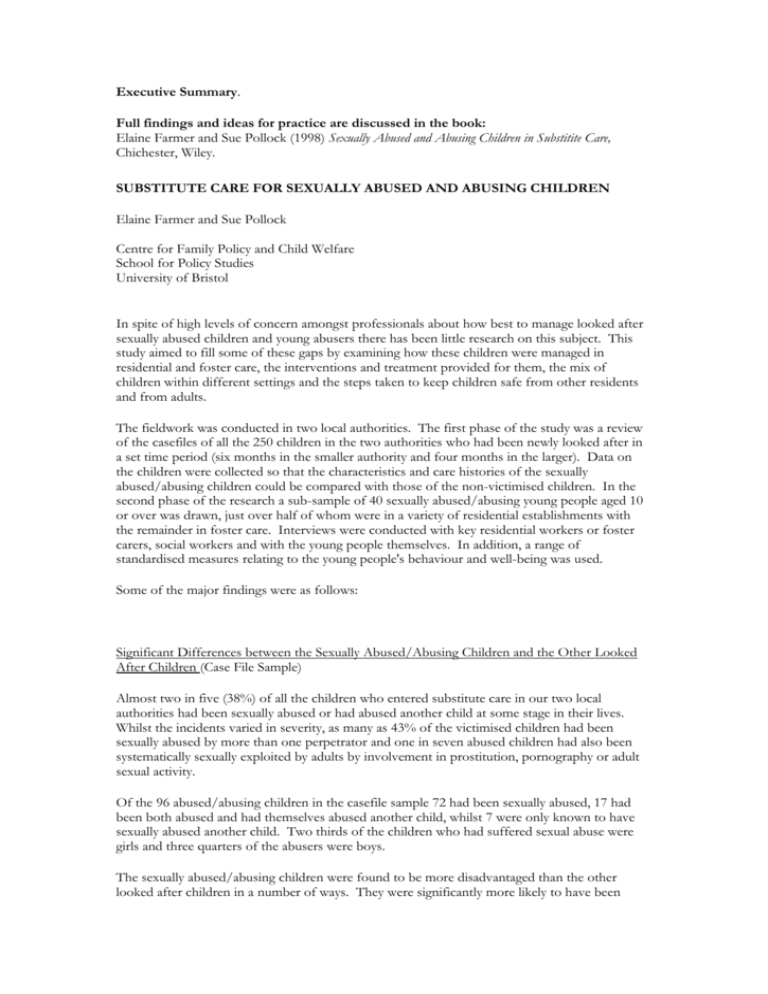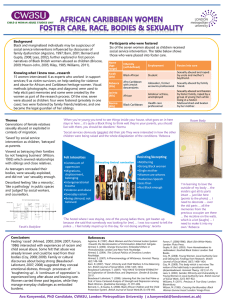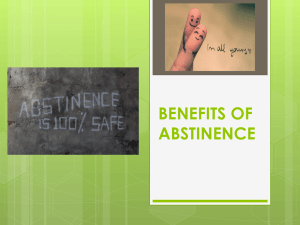
Executive Summary.
Full findings and ideas for practice are discussed in the book:
Elaine Farmer and Sue Pollock (1998) Sexually Abused and Abusing Children in Substitite Care,
Chichester, Wiley.
SUBSTITUTE CARE FOR SEXUALLY ABUSED AND ABUSING CHILDREN
Elaine Farmer and Sue Pollock
Centre for Family Policy and Child Welfare
School for Policy Studies
University of Bristol
In spite of high levels of concern amongst professionals about how best to manage looked after
sexually abused children and young abusers there has been little research on this subject. This
study aimed to fill some of these gaps by examining how these children were managed in
residential and foster care, the interventions and treatment provided for them, the mix of
children within different settings and the steps taken to keep children safe from other residents
and from adults.
The fieldwork was conducted in two local authorities. The first phase of the study was a review
of the casefiles of all the 250 children in the two authorities who had been newly looked after in
a set time period (six months in the smaller authority and four months in the larger). Data on
the children were collected so that the characteristics and care histories of the sexually
abused/abusing children could be compared with those of the non-victimised children. In the
second phase of the research a sub-sample of 40 sexually abused/abusing young people aged 10
or over was drawn, just over half of whom were in a variety of residential establishments with
the remainder in foster care. Interviews were conducted with key residential workers or foster
carers, social workers and with the young people themselves. In addition, a range of
standardised measures relating to the young people's behaviour and well-being was used.
Some of the major findings were as follows:
Significant Differences between the Sexually Abused/Abusing Children and the Other Looked
After Children (Case File Sample)
Almost two in five (38%) of all the children who entered substitute care in our two local
authorities had been sexually abused or had abused another child at some stage in their lives.
Whilst the incidents varied in severity, as many as 43% of the victimised children had been
sexually abused by more than one perpetrator and one in seven abused children had also been
systematically sexually exploited by adults by involvement in prostitution, pornography or adult
sexual activity.
Of the 96 abused/abusing children in the casefile sample 72 had been sexually abused, 17 had
been both abused and had themselves abused another child, whilst 7 were only known to have
sexually abused another child. Two thirds of the children who had suffered sexual abuse were
girls and three quarters of the abusers were boys.
The sexually abused/abusing children were found to be more disadvantaged than the other
looked after children in a number of ways. They were significantly more likely to have been
placed at some time on the child protection register (under any category), to have had a previous
care experience and to have spent longer in care than their non-abused counterparts. In
addition, tests of statistical significance showed that the sexually abused/abusing children were
more likely than the others to have had severe educational problems, (non-attendance and school
exclusion, serious behaviour problems at school, being bullied,) and to have experienced
rejection and disrupted parenting (that is multiple separations from their main parent, a parent
who had multiple partners and care which adversely affected their emotional development) and
to have been seen as troublesome (that is serious behaviour problems and being beyond control
at home). In addition, the girls were more likely than others to have become pregnant.
Once in care a number of other differences emerged. More of the sexually abused/abusing
children than the others were looked after on a statutory basis and fewer were placed with a
sibling. The abused and abusing children had more moves in care in the first six months after
admission, were more often moved between the residential and foster care sectors and had
slightly higher rates of placement breakdown than the other looked after children. Once in care
significantly more of the abused and abusing children showed new behaviour problems when
compared with their non-abused peers.
Placement and Mix
Fewer than one in five of the children with a background of sexual abuse or sexually abusing
behaviour entered care for this reason, so this aspect of their history was easily overlooked.
Moreover, incidents of sexual abuse were not well documented on casefiles and sexually abusing
behaviour by children were even less well recorded. This was partly because most had been dealt
with outside the aegis of child protection procedures so that detailed information from
investigations and case conferences was absent. Since key information about children's histories
was not held centrally on casefiles, new social workers sometimes did not know about past abuse
or the facts were minimised to secure placements. In addition fewer that a third of the young
people were formally assessed either before or during placement and over half the young people
were placed as emergencies.
In the follow-up sample we found that information about sexual abuse in the background of
42% of the abused children not been passed on to the caregivers at the time of placement and in
over half of the cases where children had sexually abused others, this was not shared with the
residential or foster carers to whom they went. Two fifths of carers complained that they were
not given enough information at the point of placement.
The context for these gaps in information was that plans for new admissions rarely paid much
attention to a consideration of whether the child would be a good match with other children
already in the placement or whether they or other children would be safe. Indeed, there was no
reliable mechanism to ensure that these issues were fully deliberated.
Risks To and From the Young People
During their placement in residential or foster care a third of the follow-up sample (12 girls and 1
boy) were sexually abused, had worked regularly as prostitutes or were vulnerable to sexual
exploitation. Almost one in five of the girls (4 of the 22) became pregnant and over one in five
of the girls (5 of the 22) alleged that they had been raped or sexually assaulted during the
placement. Of the latter, there were two allegations of sexual assault by a resident or staff
member in residential care and three instances of rape or sexual assault on young people while
they were outside the care setting.
2
During the placement which constituted the focus of the study almost one in five (7 of 36) of the
victimised young people sexually abused another child and a similar proportion of children (3 of
17) who had already sexually abused a child repeated this behaviour in their placements. This
was mainly abuse of other residents in children's homes, the children and grandchildren of foster
carers, other fostered children and siblings. Overall three quarters of the sexually abused children
(27/36) became involved in sexual activities or showed sexual behaviours which put themselves
or others at risk during the index placement.
In spite of these risks to and by the young people there was a tendency for caregivers and social
workers to normalise these sexual behaviours and to develop high thresholds before action was
taken. This was particularly true for sexual behaviours which occurred outside the care setting,
such as indiscriminate sexual activity and prostitution.
When the whole histories of the sexually abused young people in the study were examined it was
found that half of them abused another child at some stage, generally another child in care. This
evidence suggests that the experience of sexual abuse should be regarded as an important risk
factor in the later development of sexually abusing behaviour. Clearly it is important that such
risks are taken fully into account when placements are made and priority is given to ensuring that
full information about sexual abuse or sexually abusing behaviour is passed on to caregivers at
the time of placement.
Therapeutic Help
Sexual abuse was part of a pattern of disadvantage with severe emotional consequences for the
majority of the young people in the follow up sample. More than two thirds had suffered
previous physical abuse and over a third had been severely neglected. Thirty percent had
undergone multiple separations from parents and half had experienced severe rejection or
scapegoating. More than half the young people had witnessed violence between their parents
and four fifths were considered to have been beyond control at home. Almost three fifths of the
young people had self harmed or attempted suicide.
Although three fifths of the children had received some therapeutic work in the past, at least a
quarter of these sessions had ended prematurely because of dissatisfactions occasioned either by
an unsympathetic approach or by the allocation of male counsellors to girls abused by men. This
sometimes led to refusal of later offers of therapeutic assistance.
During the index placement, fewer than a third of the abused young people were provided with
work on the abuse itself, either from specialist counsellors or social workers. Even when
therapeutic help was offered, caregivers were rarely informed about what occurred in the
therapeutic sessions, although they were sometimes left to pick up the pieces when children
returned to the placement in an aggressive or unpredictable frame of mind. This was
unfortunate because it weakened the ability of young people to integrate the gains from the
therapeutic work into their everyday lives. Only one of the young abusers received any therapeutic
help which addressed the abusing behaviour.
Forty five per cent of the young people talked to their caregivers or social workers either fully or
partially about the abuse or the events connected to it. Only one child talked about her abusing
behaviour and even then not in depth. We became clear that good practice requires that
caregivers, at the time of admission, should always make it clear to children both that they know
about difficulties in their past and that the children can talk about it at any time with them, if
they wish to do so. Whilst this will not necessarily lead to an open discussion, it does lay the
ground work for opening up the issue. It is important, however, not to underestimate how
difficult this can be for caregivers who varied widely in their willingness and capacity to attend to
3
young people’s accounts and often felt unprepared and unsupported to deal with distressing
emotional issues. Listening to children’s accounts of their abuse was cited as a major source of
stress in the work.
The best outcomes in terms of behavioural gains were for those young people who were helped
to explore their difficult experiences and feelings both in a therapeutic relationship and in their
everyday lives in care. Overall, over half the children had never had the opportunity to talk in a
therapeutic setting about their experience of sexual abuse and to develop a perspective on it
which could form the basis for their recovery. There was little evidence in care planning that
information about past interventions, or from assessments on the children, were used to evaluate
children's needs for therapeutic interventions.
The Management and Placement Needs of Different Sub-Groups of Children
Among the sexually abused and abusing young people three distinct sub-groups stood out. The
particular management and placement needs of each sub-group is given below.
Young Abusers
Most of the children who had abused others were boys and a high proportion (41%) had
learning difficulties. The standardised measures of children's emotional and behavioural
problems showed that 94% of the child abusers were in the clinical or borderline range. They
often came from highly sexualised backgrounds and had been exposed to a variety of sexual
activities. The majority were placed in foster care with experienced carers and most of the
remainder entered specialist residential placements, including secure provision. The management
of abusers while in placement generally consisted of tight supervision and monitoring of the
child's activities but, with one exception, there was no work which focused on the abusing
behaviour itself. Nonetheless there were examples of good practice with children who abuse and
these are detailed in the study.
Effective management required a combination of close supervision, assistance in developing
more appropriate interpersonal boundaries and therapeutic intervention. Interventions needed
to address past and present sources of distress for the children as well as their current needs for
education and recreational activities.
The experienced caregivers who looked after the young abusers tended to be well engaged with
them and provided good care. Short-term outcomes for this group were fairly good, that is their
behaviour improved and their major needs were adequately met. However, because of the lack if
therapeutic intervention to address their abusing behaviour there were very real risks that their
abusing behaviour would re-emerge after discharge from care.
Young perpetrators for whom sex and aggression were linked required specialist placements
which could provide tight supervision and access to therapeutic help.
Young People who Showed Sexualised Behaviour
Almost two thirds of the children who were known only to have been sexually abused had
emotional and behavioural problems which fell into the clinical or borderline range. As many as
71% of the sexually abused children in our study rated themselves on the child depression
inventory as having suicidal thoughts and as seen above self-harm was not uncommon. The
4
majority of the abused young people were girls and most were placed in ordinary children's
homes.
The young people who evoked concern about their sexual behaviour and activities were
predominantly girls. Girls who dressed provocatively, offered themselves sexually to other
residents, acted flirtatiously with caregivers and made indiscriminate sexual approaches to the
boys and men whom they met raised the anxieties of residential and foster carers. Caregivers
were uncertain about how to manage these sexual behaviours and male caregivers who were
worried that an allegation might be made against them distanced themselves from the girls
Inside the placements most caregivers lacked ideas about how to deal with teenage girls who
sexualised physical contacts with them and with other young people whose backgrounds of
neglect and rejection indicated a clear need for affection and nurture, but examples of good
practice were found and are detailed in the study.
Outside the placements caregivers were generally at a loss as to how to deal with teenage girls who
were sexually indiscriminate or were involved in sexually exploitative relationships, although two
children's homes and some of the foster carers had found effective ways to exercise such
supervision. Many girls also needed basic practical information about how to minimise risks
when out alone at night.
Only half of these adolescent girls received any therapeutic intervention to help them with their
behavioural and emotional difficulties during the index placement. Because of the uncertainties
about how to manage their behaviours the girls' broader needs as vulnerable young people from
deprived backgrounds were not well met in placements. Their school attendance was very poor
and many had few if any leisure activities. The outcomes for these adolescent girls who showed
sexualised behavioiur were among the poorest of all the children in the study. Their needs were
not well met and they continued to be at considerable risk.
Young People who Were Involved in Prostitution
The only group with poorer outcomes than those of the adolescent girls who showed sexualised
behaviour was that of young people who were involved in prostitution. Almost a quarter of the
young people in the study had been involved in or were on the fringes of prostitution during
their placements, while absconding or after discharge from care. Three of these children
procured other residents from their placements for the purposes of prostitution. Young people
who worked the streets were extremely difficult to contain in any care placement, partly because
they persistently absconded and partly because caregivers had little success in altering their
behaviour. Their behaviours were resistant to change because of the lure of the money and
because of the reinforcement provided by their networks of pimps and clients.
There was a real scarcity of ideas about ways to engage and contain these young people apart
from incarceration in secure units, and no examples of effective practice. Nonetheless, it was
clear that a rapid response was required when such behaviour came to light, in order to try to
influence the child's choice of associates before the behaviour became entrenched and before too
many other children had been drawn in. Geographical distance from the child's networks
appeared to be an important ingredient of good placements as were active efforts to involve the
young person in a suitable school placement and in activities which might provide an alternative
source of esteem.
Given these findings it was not surprising that the overall outcomes for the children engaged in
prostitution were the worst for any group of young people in the study. This highlights a
5
pressing need for the development of practice ideas about engaging and assisting children who
become involved in prostitution.
Other Management Issues
There were a number of areas in which children could have been better served while they were
being looked after. More attention could profitably have been paid to the young people's
educational needs, especially in view of the fact that almost half had histories of non-school
attendance and a third had been excluded from school at some time. Some residential homes
and most foster carers gave priority to education and as a result of their efforts children were
found school places and given support in the early stages of a return to school. However, there
were also children's homes where non-attendance at school was accepted as the norm and newly
arrived young people quickly established patterns of non-attendance.
In addition, more priority needed to be given to providing information about sexual relationships
and contraceptive advice since the children in our sample were very poorly informed about these
issues whilst frequently highly sexually active. In the absence of such information the risk of
pregnancy and of sexually transmitted disease was high. Opportunities to link the behaviours
shown by the children with events from their past were often not taken, so that behaviours were
sometimes dealt with a superficial manner without a deeper understanding being sought.
Overall, about half of both the foster carers and the residential workers reported that they were
experiencing considerable stress in looking after the young people in the study. Managing young
people’s unpredictable and aggressive behaviour and self harm, fears of allegations and the
emotional burden of dealing with very sexualised behaviour were all cited as causes of stress.
Over half of the foster carers felt that their needs for support from social services departments
were not being met and this was true for a third of residential workers. Given the extent of the
young people's disturbance and the trauma in their lives there was a clear need for better training,
increased levels of support and regular consultancy to the caregivers who were attempting to give
them a secure base and keep them and other children safe from harm.
References
Elaine Farmer and Sue Pollock (1998) Sexually Abused and Abusing Children in Substitite Care,
Chichester, Wiley.
Elaine Farmer and Sue Pollock (1999) 'Sexually Abused and Abusing Children: their Impact on
"Foster Siblings" and Other Looked After Children', in Audrey Mullender (ed) We are Family:
Sibling relationships in placement and beyond, London, British Agencies for Adoption and Fostering,
pp.227-238.
Elaine Farmer and Sue Pollock (1999) 'Mix and Match: Planning to Keep Looked After Children
Safe', Special Issue on Children in the Public Care, Child Abuse Review, Vol. 8, No. 6, 377-391.
Sue Pollock and Elaine Farmer (2001) ‘Substitute Care for Sexually Abused and Abusing
Children’, Adoption and Fostering, Vol. 25, No.2, pp.56-59.
Elaine Farmer and Sue Pollock (2003) ‘Managing Sexually Abused and/or Abusing Children in
Substitute Care’, Child and Family Social Work, Issue 8.2, pp.101-112, ISSN 1356-7500.
6
Elaine Farmer (2004) ‘Patterns of Placement, Management and Outcome for Sexually Abused
and/or Abusing Children in Substitute Care’, British Journal of Social Work, Vol 34, No3, pp.375393.
Sue Pollock and Elaine Farmer Sue Pollock (2005) ‘A hidden population: understanding the
needs of sexually abused and abusing children in substitute care’, Adoption and Fostering, Vol.29,
No.2, pp.18-33.
7






